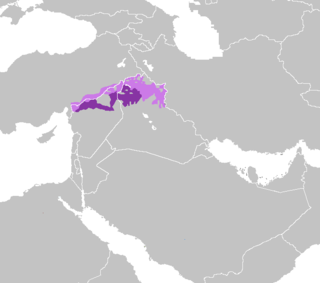North Mesopotamian Arabic
| North Mesopotamian Arabic | |
|---|---|
| Moslawi Arabic Mardelli Arabic Qeltu Mesopotamian Arabic Syro-Mesopotamian Arabic | |
| لهجة موصلية | |
| Native to | Iraq, Syria, Turkey[1] |
| Speakers | 10 million (2019–2023)[1] |
Afro-Asiatic
| |
| Dialects | |
| Arabic alphabet | |
| Language codes | |
| ISO 639-3 | ayp |
| Glottolog | nort3142 |
| ELP | North Mesopotamian Arabic |
 | |
North Mesopotamian Arabic, also known as Moslawi (meaning 'of Mosul'), Mardelli (meaning 'of Mardin'), Mesopotamian Qeltu Arabic, or Syro-Mesopotamian Arabic, is one of the two main varieties of Mesopotamian Arabic, together with Gilit Mesopotamian Arabic.[1]
Relationship to Gilit Mesopotamian
Mesopotamian Arabic has two major varieties: Gelet Mesopotamian Arabic and Qeltu Mesopotamian Arabic. Their names derive from the form of the word for "I said" in each variety.[2] Gelet Arabic is a Bedouin variety spoken by Muslims (both sedentary and non-sedentary) in central and southern Iraq and by nomads in the rest of Iraq. Qeltu Arabic is an urban dialect spoken by Non-Muslims of central and southern Iraq (including Baghdad) and by the sedentary population (both Muslims and Non-Muslims) of the rest of the country.[3] Non-Muslims include Christians, Yazidis, and Jews, until most Iraqi Jews left Iraq in the 1940s–1950s.[4][5] Geographically, the gelet–qeltu classification roughly corresponds to respectively Upper Mesopotamia and Lower Mesopotamia.[6] The isogloss is between the rivers Tigris and Euphrates, around Fallujah and Samarra.[6]
During the
| s-stem | Bedouin/gelet | Sedentary/qeltu |
|---|---|---|
| 1st sg. | ḏạrab-t | fataḥ-tu |
| 2nd m. sg. | ḏạrab-t | fataḥ-t |
| 2nd f. sg. | tišṛab-īn | tǝšrab-īn |
| 2nd pl. | tišṛab-ūn | tǝšrab-ūn |
| 3rd pl. | yišṛab-ūn | yǝšrab-ūn |
Dialects
Qeltu dialects include:[6]
- Qeltu
- Anatolian Qeltu
- Tigris Qeltu
- Euphrates Qeltu
- Khawetna (Syria, Iraq, Turkey)
- Deir ez-Zor
- Anah and Abu Kamal
- Hit, Iraq
The peripheral Anatolian Arabic varieties in Siirt, Muş and Batman are quite divergent.[citation needed]
Cypriot Arabic shares a number of common features with North Mesopotamian Arabic, and one of its pre-Cypriot medieval antecedents has been deduced as belonging to this dialect area.[11][12] However, its current form is a hybrid of different varieties and languages, including Levantine Arabic and Greek.[11]
Aramaic substrate
References
- ^ a b c North Mesopotamian Arabic at Ethnologue (27th ed., 2024)

- ISBN 0-19-823989-0.
- .
- OCLC 1059441655.
- S2CID 134361362.
- ^ a b c Ahmed, Abdulkareem Yaseen (2018). Phonological variation and change in Mesopotamia: a study of accent levelling in the Arabic dialect of Mosul (PhD thesis). Newcastle University.
- ^ ISBN 978-3-11-019987-1.
- OCLC 989950951.
- OCLC 1059441655.
- ^ .
- ^ ISBN 0-7486-1436-2.
- ISBN 0-19-929082-2.
- ISBN 978-84-695-7829-2.
- ISBN 978-1-136-78805-5.
- ^ R. J. al-Mawsely, al-Athar, al-Aramiyyah fi lughat al-Mawsil al-amiyyah (Lexicon: Aramaic in the popular language of Mosul): Baghdad 1963
- JSTOR 10.5325/j.ctv1w36pkt.
